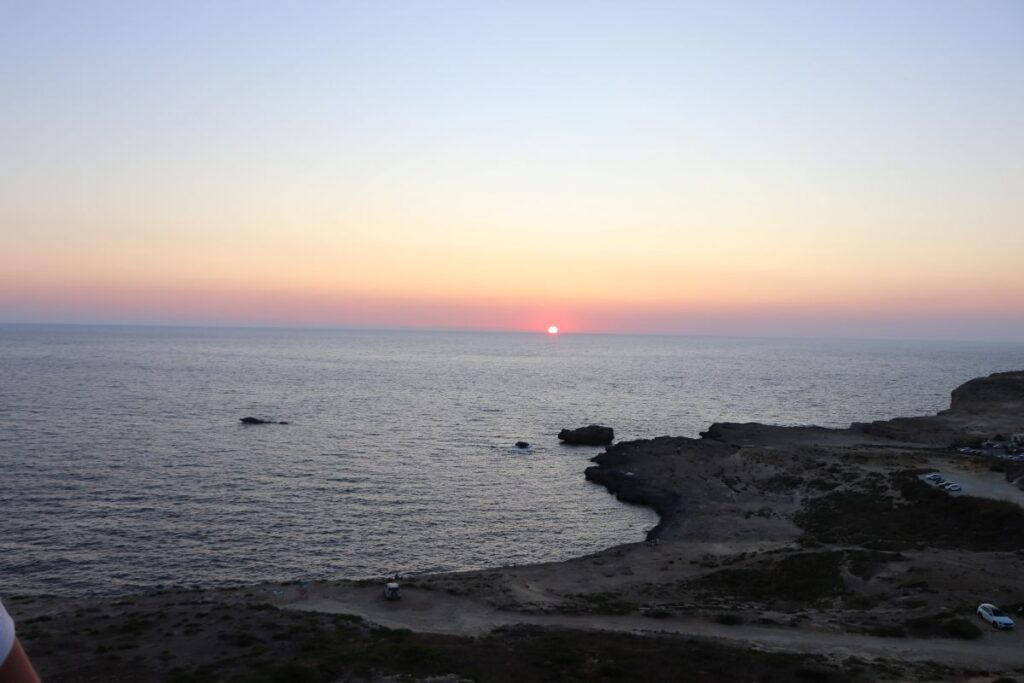The varied geomorphology, ecology and history at Dwejra, Gozo makes it a really unique place in the Maltese islands.
A number of sinkholes and a coastline characterised by sheer cliffs makes for breathtaking scenery, crowned by the Fungus Rock or Ħaġret il-Ġeneral, at the entrance of one of the inlets.
Seabirds make the deep caves within the limestone cliffs their safe home, where year after year they raise their young before they too embark on a life out at sea. In fact, all three species found on the Maltese islands – Scopoli’s shearwater (Ċiefa), Yelkouan shearwater (Garnija) and the European storm-petrel (Kanġu ta’ Filfla) – breed in the surroundings of Dwejra.
Guarding the coastline is Dwejra Tower, built in 1652 by the Knights of St John, and now cared for by heritage NGO Din l-Art Ħelwa. There is no better place to enjoy panoramic views and beautiful sunsets than from the top floor of the restored watchtower.
On one of the first evenings of the summer, three NGOs came together to give members of the public a memorable yet educational tour of the many wonders of the site.
In addition to the now yearly shearwater colony walks organised by BirdLife Malta and hosted by Din l-Art Ħelwa at the tower, participants were in for a special treat: the Astronomical Society of Malta showed up with one of their telescopes and vast knowledge of the night sky.
It was truly magical to get transported thousands of lightyears away and observe nebulae and far-flung galaxies come into focus, while at the same time listening to shearwaters calling in the dark – a testimony of the living and breathing planet Earth.
However, we should not take these natural spectacles for granted. Dwejra on Gozo’s west coast is the best remaining place in the Maltese islands where such a sea of stars can be enjoyed, thanks to its Dark Sky Heritage Area designation.
Light pollution is a serious problem in Malta, not only threatening the enjoyment and science of astronomy but also wildlife and human health. Luckily, as professor Joseph Caruana explained during the evening, there are several easy and straightforward measures to reduce light pollution, such as using illumination only when required, avoiding excessive lighting and changing fittings to warm light that is directed downwards without spill.
When it comes to Dwejra, all lights are to remain switched off for the entirety of the night. This is not only important for stargazing, but also the shearwaters. They come in at night for a reason: the cover of darkness means they can do so protected from natural predators. Artificial light disrupts this behaviour, and where this becomes excessive, breeding prospects diminish.
On the very same night we met up, a super yacht anchored in the bay lit up the cliffs with bright lights, completely unnecessarily and in breach of site regulations.
There is another way mariners can help preserve local wildlife. Biosecurity is the main focus of the current LIFE Tetide project, which BirdLife Malta are partners in. Invasive non-native species like rats are very good at moving around, causing havoc among native flora and fauna when they reach new places.
Boat owners should take special care such that they do not unknowingly transport any of these unwanted passengers while sailing around cliffs and islets. In fact, even those who do not own a boat can contribute when visiting the countryside, and especially coastal areas, by taking any litter home with them. Food waste left outside, in open or overflowing bins, contributes to the proliferation of invasive species, such as rats.
Shearwaters and distant starlight give us hope that despite the many environmental problems faced by the Maltese islands, nature can still thrive, and we hope to be able to enjoy such natural spectacles in the future.
This article was written by Martin Austad from BirdLife Malta.
Learn more about Malta’s shearwaters here.
